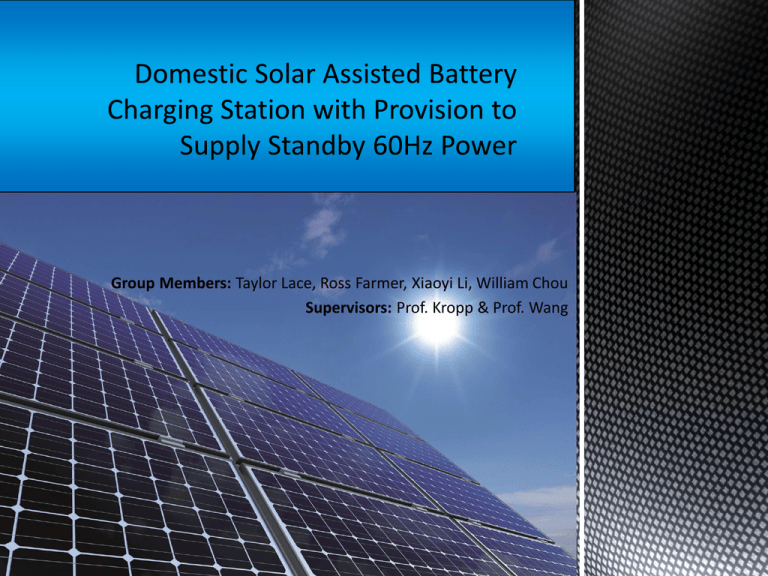Domestic Solar Assisted Battery Charging Station with Provision to
advertisement

Group Members: Taylor Lace, Ross Farmer, Xiaoyi Li, William Chou Supervisors: Prof. Kropp & Prof. Wang o Optimize use of clean energy for residential setting Uninterrupted power to household systems, despite outages o Management of intermittent solar power source Reduction in power draw from grid, subsidized by clean solar o Intelligent use of large energy storage availability (ex: electric vehicles) Further progress towards efficient sustainability o Maximize power output from solar panels o Controlled charge/discharge of battery power o Generate pure AC sine wave from DC supply o Synchronize AC sine wave with grid • Maximize photovoltaic power production • Maintain a high quality output to the DC Bus • Simulations on circuit performance done via Matlab/Simulink • Arduino Uno microcontroller • Current sensing required by MPPT • Output filtering to hold DC bus constant Solar Cell 18V Boost Output 50V • • A constant 50V output achieved through the Boost circuit from a 18V input Feedback and self-adjusting MPPT via Arduino control board • Bi-directional Power flow, linking Battery and Bus • Lower (buck) the DC bus voltage to ideal charging conditions for battery • Increase (boost) the outgoing battery voltage to maintain constant DC bus voltage, leading to house • Isolated controls for driving buck/boost levels and switching • Power flow from low voltage battery towards higher voltage DC bus → Power Flow 140 • Boost capabilities relative to amount of inductance and capacitance Input Voltage 120 25KΩ 100 Voltage (V) • PWM signal from programmable Arduino board used to a control output voltage via isolation circuit 50KΩ 80 100KΩ 60 200KΩ 40 500KΩ 20 1MΩ 0 90 70 50 Duty Ratio 30 10 2MΩ 5MΩ • Large boost voltages are easily achieved at output with exchange of inductors o Power flow from high voltage DC bus (grid) to lower voltage battery charging o Same control scheme as boost mode ←Power Flow o Significant voltage dropping would be required for real application battery charging from ≈120V input 25 Voltage (V) o Voltage and Current sensors relaying information to Arduino control board could allow for instantaneous self-adjustment of circuit 30 20 Input Voltage 15 10 Output Voltage 5 0 0 3 7 13 20 30 Duty Cycle 40 50 65 Capturing grid frequency and amplitude feed into the programmable Microprocessor Programming the microprocessor with control techniques including PLL, PI controller and Park Transformation Microprocessor processes the real time data and generate PWM waveform Toggle the GPIO in of the microprocessor to generate sinusoidal PWM signal Hardware Issue: o Software Issue: o Arduino board to ZedBoard Software change-over complications Challenges: o Configure peripheral of ZedBoard in Xilinx XPS o Write constraint files o Time function on ZedBoard o Clock & Interrupt System On A Chip(SoC) USB UART ARM Processor: 1GHz A-D converter JTAG Unipolar PWM Signal GPIO: 3.3 V DC ZedBoard Full Bridge Inverter Unipolar PWM Sine Wave • Comparing sine wave to a triangle wave to determine when to switch • Only 1 MOSFET in each leg is active at any given time LC Low Pass Filter • Filter out the high frequency triangle wave • Cut off frequency close to desired 60 HZ and well below triangle to allow high attenuation Sine Wave! Challenges… Increasing gate voltage Sizing of inductor and capacitor Measurement for feedback control Increase output voltage …Solutions Voltage Sensor Optocouplers Current Sensor • Single Phase Inverter Increase Output voltage • Bi-directional Buck Boost converter: Switching for instantaneous mode change between modes Automation of the switching circuit for self adjustment. • Inverter Controller Debug the controller C code Adjust Frequency to constant 60Hz • MPPT Controlled Boost Converter Upgrade current sensor Increase efficiency of MPPT algorithm





